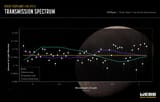Search Results
7/5/2025, 12:33:22 PM
It was always extremely unlikely that JWST would find life.
Transit spectroscopy works well when the planet is a significant fraction of the host star's diameter. So Jupiter mass planets for Sun-like stars, but rocky planets are possible to study around red dwarfs (M dwarfs). So Earth like planets around Sun-like stars are out of the question. If M dwarfs turn out to be uninhabitable due to stellar activity then it's hopeless.
Then in terms of features, transit spectroscopy is not sensitive to what is on the surface. So it cannot measure plants photosynthesizing on the planet. Only what is in the atmosphere. And only molecules which have strong features in JWST's wavelength range. Molecular oxygen does not have features in that range. Ozone (O3) does, but it is harder to detect.
Then when it comes to actually observing the transits you need to stack dozens of transits to get enough signal to measure it's atmosphere. This takes years for slower orbiting planets. It also means the first published planets are very close in and have rapid orbits. So far, the rocky planets that have been published are all consistent with having no significant atmosphere at all. There are no high quality transit spectra of any rocky planet.
Pic related is the best transit spectrum so far of a rocky planet by JWST. This is two transits, about 9 hours of telescope time. As you can see the spectrum is consistent with anything, it's not even clear if it has an atmosphere.
What has also emerged in the era of JWST is that there are lots of systematic effects in transit spectroscopy which previous data didn't have the sensitivity to see, (sunspots, activity, extractions, correlated noise). These can limit the overall sensitivity that can be reached.
JWST was never designed to find life. Exoplanets were an afterthought, it was built to study early galaxies, which it does very well.
Transit spectroscopy works well when the planet is a significant fraction of the host star's diameter. So Jupiter mass planets for Sun-like stars, but rocky planets are possible to study around red dwarfs (M dwarfs). So Earth like planets around Sun-like stars are out of the question. If M dwarfs turn out to be uninhabitable due to stellar activity then it's hopeless.
Then in terms of features, transit spectroscopy is not sensitive to what is on the surface. So it cannot measure plants photosynthesizing on the planet. Only what is in the atmosphere. And only molecules which have strong features in JWST's wavelength range. Molecular oxygen does not have features in that range. Ozone (O3) does, but it is harder to detect.
Then when it comes to actually observing the transits you need to stack dozens of transits to get enough signal to measure it's atmosphere. This takes years for slower orbiting planets. It also means the first published planets are very close in and have rapid orbits. So far, the rocky planets that have been published are all consistent with having no significant atmosphere at all. There are no high quality transit spectra of any rocky planet.
Pic related is the best transit spectrum so far of a rocky planet by JWST. This is two transits, about 9 hours of telescope time. As you can see the spectrum is consistent with anything, it's not even clear if it has an atmosphere.
What has also emerged in the era of JWST is that there are lots of systematic effects in transit spectroscopy which previous data didn't have the sensitivity to see, (sunspots, activity, extractions, correlated noise). These can limit the overall sensitivity that can be reached.
JWST was never designed to find life. Exoplanets were an afterthought, it was built to study early galaxies, which it does very well.
Page 1
